List 2 Characteristics From the Following Art Eras Classical Greece
Beginnings of Classical Greek and Roman Art and Architecture
Mycenaean Influences 1600-1100 BCE

Considered the first Greeks, the Mycenaeans had a lasting influence on later Greek art, architecture, and literature. A statuary historic period civilisation that extended through modern day southern Greece as well as coastal regions of modern day Turkey, Italy, and Syria, Mycenaea was an elite warrior guild dominated by palace states. Divided into three classes - the king'due south attendants, the common people, and slaves - each palace state was ruled by a king with military, political, and religious authority. The gild valorized heroic warriors and made offerings to a pantheon of gods. In after Greek literature, including Homer's The Iliad and The Odyssey, the exploits of these warriors and gods engaged in the Trojan State of war had become legendary and, in fact, appropriated past later Greeks as their founding myths.

Agriculture and trade were the economical engines driving Mycenaean expansion, and both activities were enhanced by the engineering genius of the Mycenaeans, as they constructed harbors, dams, aqueducts, drainage systems, bridges, and an extended network of roads that remained unrivaled until the Roman era. Innovative architects, they adult Cyclopean masonry, using large boulders, fit together without mortar, to create massive fortifications. The name for Cyclopean stonework came from the afterwards Greeks, who believed that only the Cyclops, vehement ane-eyed giants of myth and legend, could accept lifted the stones. To lighten the heavy load above gates and doorways, the Mycenaeans also invented the relieving triangle, a triangular space above the lintel that was left open or filled with lighter materials.
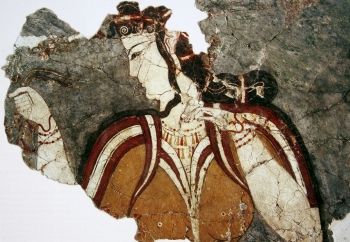
The Mycenaeans first developed the acropolis, a fortress or citadel, built on a hill that characterized later Greek cities. The king'southward palace, centered on a megaron, or circular throne room with iv columns, was busy with vividly colored frescoes of marine life, battle, processions, hunting, and gods and goddesses.
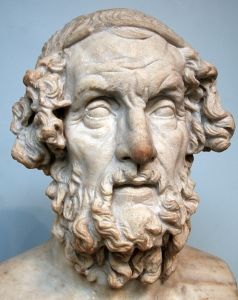
Scholars all the same debate how the Mycenaean civilization declined, and theories include invasions, internal conflict, and natural disasters. The era was followed by what has been called the Greek Dark Ages, though it is also known as the Homeric Age and the Geometric period. The term Homeric Historic period refers to Homer whose poems narrated the Trojan War and its backwash. The term Geometric menses refers to the era'southward style of vase painting, which primarily employed geometric motifs and patterns.
Greek Archaic Menses 776-480 BCE

The Archaic Catamenia began in 776 BCE with the establishment of the Olympic Games. Greeks believed that the able-bodied games, which emphasized human achievement, gear up them autonomously from "barbarian," non-Greek peoples. The Greeks' valorization of the Mycenaean era as a heroic aureate age led them to idealize male athletes, and the male figure became dominant subjects of Greek fine art. The Greeks felt that the male person nude showed not only the perfection and beauty of the body but also the nobility of grapheme.
The Greeks adult a political and social construction based upon the polis, or city-state. While Argus was a leading center of trade in the early on role of the era, Sparta, a city state that emphasized military prowess, grew to be the virtually powerful. Athens became the pioneering forcefulness in the art, culture, science, and philosophy that became the basis of Western civilization. Though the era was dominated by the dominion of tyrants, Solon, a philosopher male monarch, became the ruler of Athens around 594 BCE and established notable reforms. He created the Council of Four Hundred, a body that could question and claiming the king, ended the do of putting people into slavery for their debts, and established a ruling class based on wealth rather than descent. Extensive sea-faring trade drove the Greek economy, and Athens, along with other city-states, began establishing trading posts and settlements throughout the Mediterranean. Equally a effect of these forays, Greek cultural values spread to other cultures, including the Etruscans in southern Italy, influencing and co-mingling with them.
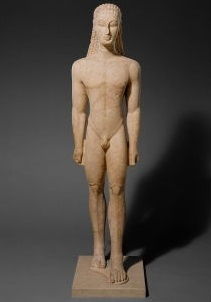
Figurative sculpture was the greatest artistic innovation of the Primitive menstruation as it emphasized realistic, though idealized, figures. Influenced by Egyptian sculpture, the Greeks transformed the frontal poses of pharaohs and other notables into works known as kouros (young men) and kore (young women), life-sized sculptures that were first developed in the Cyclades islands in the 7th century BCE. During the late Archaic period, private sculptors, including Antenor, Kritios, and Nesiotes, were celebrated, and their names preserved for posterity.

The late Primitive menstruation was marked by new reforms, as the Athenian lawgiver Cleisthenes established new policies in 508BC that led to him beingness dubbed "the begetter of republic." To celebrate the cease of the rule of tyrants, he commissioned the sculptore Antenor to complete a statuary statue, The Tyrannicides (510 BCE), depicting Harmonides and Aristogeion, who had assassinated Hipparchos, the brother of the tyrant Hippias, in 514 BCE. Though the ii were executed for the crime, they became symbols of the movement toward democracy that led to the expulsion of Hippias four years later and were considered to be the only contemporary Greeks worthy enough to be granted immortality in art. The commission of Antenor'south piece of work was the offset public funded art commission, and the subject was so resonant that, when Antenor'southward work was taken during the 483 BCE Persian invasion, Kritios was commissioned to create a replacement. Kritios's The Tyrannicides (c. 477 BCE) developed what has been chosen the astringent style, or the Early on Classical style, every bit he depicted realistic motion and private characterization, which had a great influence on subsequent sculpture.
Classical Greece 480-323 BCE

Classical Greece, also known as the Gold Historic period, became central both to the later Roman Empire and western culture, in philosophy, politics, literature, scientific discipline, art, and architecture. The keen Greek historian of the era Thucydides, called the general and populist statesman Pericles "Athens's first citizen." Equal rights for citizens (which merely meant adult Greek males), democracy, freedom of speech, and a society ruled by an assembly of citizens defined Greek regime. Pericles launched the rebuilding of the Parthenon (447-432 BCE) in Athens, a project overseen by his friend, the sculptor Phidias, and established Athens every bit the virtually powerful city state, expanding its influence throughout the Mediterranean region.

The Classical era also saw the establishment of Western philosophy in the teachings and writings of Socrates, Plato, and Aristotle. The philosophy of Socrates survived through Plato's written accounts of his instructor's dialogues, and Plato went on to found the University in Athens around 387 BCE, an early paradigm of all later academies and universities. Many leaders studied at the Academy, including most notably Aristotle, and it became a leading strength known throughout the world for the importance of scientific and philosophical inquiry based upon the conventionalities in reason and knowledge. While their philosophies diverged in key respects, Plato and Aristotle concurred in seeing art every bit an imitation of nature, aspiring to the beautiful.

Additionally, the emphasis on individuality resulted in a more than personalized art, and private artists, including Phidias, Praxiteles, and Myron, became historic. Funerary sculpture began depicting real people (instead of idealized types) with emotional expression, while at the same fourth dimension, bronze works arcadian the human being form, particularly the male nude. Praxiteles, though, pioneered the female nude in his Aphrodite of Knidos (fourth century BCE), a work that has been referenced time and fourth dimension again in the ensuing centuries.
Hellenistic Greek 323-31 BCE
The expiry of Alexander the Great in 323 BCE marked the showtime of the Hellenistic catamenia. Having amassed a vast empire beyond Greece that included parts of Asia, N Africa, Europe and not having named a successor instigated a war between Alexander's generals for control of his empire, and local leaders jockeyed to regain control of their regions. Eventually, iii generals agreed to a ability-sharing relationship and carved the Greek empire into three different regions. While the mainland Greek cultural influence declined, Alexandria in Egypt and Antioch in modern 24-hour interval Syria became important centers of Hellenistic civilisation. Many Greeks emigrated to other parts of the fractured empire, "Hellenizing the world," as art historian John Griffiths Pedley wrote.
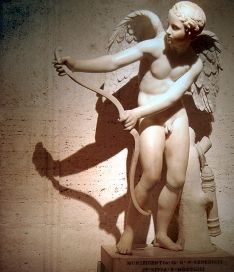
Despite the splintering of the empire, great wealth led to imperial patronage of the arts, particularly in sculpture, painting, and architecture. Alexander the Peachy's official sculptor had been Lysippus who, working in statuary afterward Alexander'south death, created works that marked a transition from the Classical to the Hellenistic style. Some of the most famous works of Greek art, including the Venus de Milo (130-100 BCE) and the Winged Victory of Samothrace (200-190 BCE) were created in the era.

Architecture turned toward urban planning, as cities created complex parks and theaters for leisure. Temples took on colossal proportions, and the architectural way employed the Corinthian order, the nearly decorative of Classical orders. Pergamon became a vital center of culture, known for its jumbo complexes, as exemplified by in the Pergamon Chantry (c. 166-156 BCE) with its extensive and dramatic friezes. During the Hellenistic period, the Greeks gradually fell to the dominion of the Roman Republic, every bit Rome conquered Macedonia in the Boxing of Corinth in 146 BCE. Upon his expiry in 133 BCE, King Attalus III left the Kingdom of Pergamon to the Romans. Though Greek rebellions followed, they were crushed in the following century.
Roman Republic 509 BCE - 26 CE
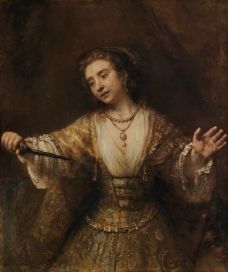
Rome began as a city-state ruled by kings, who were elected by the nobleman of the Roman Senate, and so became a Commonwealth when Lucius Tarquinii Superbus, the concluding king, was expelled in 509BC. Considering his son had raped Lucretia, a married noblewoman, who took her own life, Tarquinii was deposed by her husband, her begetter, and Lucius Junius Brutus, Tarquinii's nephew. The story became both part of Roman history and a field of study depicted in fine art throughout the following centuries.

With the kingship abolished, the Democracy was established with a new organization of government led past 2 consuls. As the patricians, the upper course who governed Rome, were frequently in disharmonize with the plebeians, or common people, an accent was put upon city planning, including flat buildings called insulae and public entertainments that featured gladiator fights and horse races to keep the people happy, a blazon of dominion that the Roman poet Juvenal described equally "breadstuff and circuses." Cities were planned on a filigree system, while architecture and technology projects were transformed by the development of physical in the 3rd century. Rome was primarily a military land, frequently at state of war with neighboring tribes in Italia at the beginning. Various military campaigns resulted in the conquest and destruction of Carthage, a Due north African kingdom, in three Punic wars, the conquest of the Republic of macedonia and its eastern territories, and Greece in the 2nd century BCE resulted in geographically expansive empire.
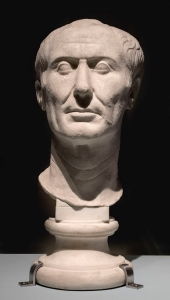
Roman civilisation adopted many of the myths, gods, and heroic stories of the Greeks, while emphasizing their own tradition of the mas majorum, the mode of the ancestors, a kind of contractual obligation with the gods and the founding fathers of Rome. Greek works, taken as spoils of war, were extensively copied and displayed in Roman homes and became a primary influence upon Roman art and compages. The ascent of Julius Caesar, following his triumph over the Gauls in northern Europe, marked the end of the Democracy, as he was assassinated in 44 BCE by a number of senators in order to prevent him existence alleged emperor. His death plunged the Commonwealth into a civil war, fought past his erstwhile general Marc Antony allied with Cleopatra, queen of Egypt, against the forces of Pompeius and the forces of Caesar'southward great nephew and heir, Octavian.
Regal Rome 27 BCE - 393 CE

While the assassins may have staved off the crowning of Caesar as emperor, eventually an emperor was named. Regal Rome begins with the crowning of Octavian as the commencement emperor, who came to be known every bit Augustus. In his almost forty-5 year reign, he transformed the city, establishing public services, including the first police force force, fire fighting strength, postal organization, and municipal offices, while creating revenue and taxation systems that were the blueprint for the Empire in the following centuries. He too launched a new building program that included temples and notable public buildings, and he transformed the arts, commissioning works like the Augustus of Prima Porta (1st century CE) that depicted him as an ideal leader in a classical style that harkened back to Greece. He also commissioned The Aeneid (29-19 BCE) an epic poem by the poet Virgil that divers Rome and became a approved work of Western literature. The poem described the mythical founding of Rome, relating the journeying of Aeneas, the son of Venus and Prince of Troy, who fled the Sack of Troy to arrive in Italy, where, fighting and defeating the Etruscan rulers, he founded Rome.
The Royal era was divers past the monumental grandeur of its architecture and its luxurious lifestyle, every bit wealthy residences were lavishly decorated with colorful frescoes, and the upper class, throughout the Empire, commissioned portraits. The Empire ended with the Sack of Rome in 393 CE, though past that time, its power had already declined, due to increasingly capricious emperors, internal conflict, and rebellion in its provinces. The conversion of Emperor Constantine to Christianity and the moving of the imperial majuscule from Rome to Constantinople in 313 CE established the rising power of the Byzantine Empire.
Classical Greek and Roman Art and Architecture: Concepts, Styles, and Trends
The Golden Ratio

The Greeks believed that truth and dazzler were closely associated, and noted philosophers understood beauty in largely mathematical terms. Socrates said, "Measure and proportion manifest themselves in all areas of beauty and virtue," and Aristotle advocated for the golden mean, or the centre style, that led to a virtuous and heroic life by fugitive extremes. For the Greeks, dazzler derived from the combination of symmetry, harmony, and proportion. The gilded ratio, a concept based on the proportions between two quantities, every bit divers past the mathematicians Pythagoras (6th century BCE) and Euclid (323-283 BCE), was thought to be the virtually beautiful proportion. The golden ratio indicates that the ratio between 2 quantities is the same every bit the ratio between the larger of the two and their sum. The Parthenon (447-432 BCE) employed the golden ratio in its design and was fêted equally the nigh perfect building imaginable. Considering the creative person Phidias oversaw the building of the temple, the golden ratio became commonly known past the Greek letter phi, in honor of Phidias. The golden ratio had a noted impact on later artists and architects, influencing the Roman builder Vitruvius, whose principles informed the Renaissance, as seen in the work and theory of Leon Battista Alberti, and mod architects, including Le Corbusier.
Greek Compages

Best known for its temples, using a rectangular design framed by colonnades open up on all sides, Greek architecture emphasized formal unity. The building became a sculptural presence on a high colina, as art historian Nikolaus Pevsner wrote, "The plastic shape of the [Greek] temple ... placed earlier us with a physical presence more than intense, more live than that of any afterwards building."
The Greeks developed the iii orders - the Doric, the Ionic, and the Corinthian - which became office of the primal architectural vocabulary of Rome and later on much of Europe and the United States. Developed in different parts of Greece and at different times, the distinction betwixt the orders is primarily based upon the differences between the columns themselves, their capitals, and the entablature higher up them. The Doric order is the simplest, using smoothen or fluted columns with circular capitals, while the entablature features add together a more circuitous decorative chemical element in a higher place the simple columns. The Ionic column uses volutes, from the Latin word for scroll, as a decorative element at the top of the capital letter, and the entablature is designed so that a narrative frieze extends the length of the building. The late Classical Corinthian order, named for the Greek urban center of Corinth, is the well-nigh decorative, using elaborately carved capitals with an acanthus leaf motif.

Originally, Greek temples were often built with wood, using a kind of mail and axle construction, though stone and marble were increasingly employed. The get-go temple to be built entirely of marble was the Parthenon (447-432 BCE). Greek architecture besides pioneered the amphitheater, the agora, or public square surrounded by a pillar, and the stadium.The Romans appropriated these architectural structures, creating monumental amphitheaters and revisioning the agora equally the Roman forum, an all-encompassing public square that featured hundreds of marble columns.
Roman Architecture and Engineering

Roman architecture was so innovative that information technology has been called the Roman Architectural Revolution, or the Concrete Revolution, based on its invention of physical in the 3rd century. The technological development meant that the course of a structure was no longer constrained past the limitations of brick and masonry and led to the innovative employment of the arch, the barrel vault, the groin vault, and the dome. These new innovations ushered in an age of monumental architecture, as seen in the Colosseum and civil engineering projects, including aqueducts, flat buildings, and bridges. The Romans, as architectural historian D.S. Robertson wrote, "were the outset builders in Europe, perhaps the first in the earth, fully to appreciate the advantages of the arch, the vault and the dome." They pioneered the segmental arch - essentially a flattened arch, used in bridges and private residences - the extended arch, and the triumphal arch, which celebrated the emperors' neat victories. But information technology was their employment of the dome that had the near pregnant touch on on Western civilization. Though influenced by the Etruscans, particularly in their utilize of arches and hydraulic techniques, and the Greeks, Romans withal used columns, porticos, and entablatures even when technological innovations no longer required them structurally.
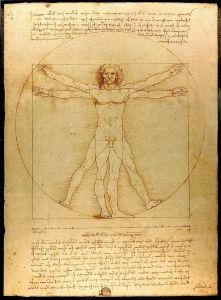
Though footling is known of his life across his work as a military machine engineer for Emperor Augustus, Vitruvius was the well-nigh noted Roman architect and engineer, and his De architectura (On Architecture) (30-fifteen BCE), known as X Books on Compages, became a canonical piece of work of subsequent architectural theory and practice. His treatise was dedicated to Emperor Augustus, his patron, and was meant to be a guide for all way of edifice projects. His work described town planning, residential, public, and religious building, every bit well as building materials, water supplies and aqueducts, and Roman machinery, such as hoists, cranes, and siege machines. As he wrote, "Architecture is a scientific discipline arising out of many other sciences, and adorned with much and varied learning." His belief that a structure should take the qualities of stability, unity, and beauty became known as the Vitruvian Triad. He saw architecture imitating nature in its proportionality and ascribed this proportionality to the human grade as well, famously expressed later in Leonardo da Vinci'due south Vitruvian Man (1490).
Vase Painting

Vase painting was a noted element of Greek art and provides the best example of how Greek painting focused primarily on portraying the homo form and evolved toward increased realism. The earliest style was geometric, employing patterns influenced by Mycenaean art, simply rapidly turned to the human being figure, similarly stylized. An "Orientalizing" period followed, as Eastern motifs, including the sphinx, were adopted to be followed by a black figure style, named for its colour scheme, that used more authentic particular and figurative modeling.
The Classical era adult the red figure manner of vase painting, which created the figures by strongly outlining them against a blackness background and allowed for their details to be painted rather than incised into the clay. Equally a result, variations of colour and of line thickness allowed for more curving and rounded shapes than were present in the Geometric style of vases.
Greek and Roman Painting
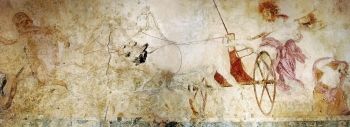
While Classical Art is noted primarily for its sculpture and architecture, Greek and Roman artists made innovations in both fresco and panel painting. About of what is known of Greek painting is ascertained primarily from painting on pottery and from Etruscan and later Roman murals, which are known to take been influenced by Greek artists and, sometimes, painted by them, as the Greeks established settlements in Southern Italy where they introduced their art. Hades Abducting Persephone (iv th century BCE) in the Vergina tombs in Macedonia is a rare case of a Classical era mural painting and shows an increased realism that parallels their experiments in sculpture.

Roman panel and fresco paintings survived in greater number than Greek paintings. The 1748 excavation of Pompeii, a Roman city that was buried almost instantaneously in the eruption of Mount Vesuvius in 79 CE, led to the groundbreaking discovery of many relatively well-preserved frescos in noted Roman residences, including the Business firm of the Vettii, the Villa of Mysteries, and the House of the Tragic Poet. Fresco paintings brought a sense of light, infinite, and color into interiors that, lacking windows, were often dark and cramped. Preferred subjects included mythological accounts, tales from the Trojan war, historical accounts, religious rituals, erotic scenes, landscapes, and nevertheless lifes. Additionally, walls were sometimes painted to resemble brightly colored marble or alabaster panels, enhanced past illusionary beams or cornices.
Greek Sculpture

Influenced by the Egyptians, the Greeks in the Primitive period began making life-sized sculptures, but rather than portraying pharaohs or gods, Greek sculpture largely consisted of kouroi, of which there were three types - the nude fellow, the dressed and standing young woman, and a seated woman. Famous for their grinning expressions, dubbed the "Archaic smile", the sculptures were used equally funerary monuments, public memorials, and votive statues. They represented an ideal type rather than a particular individual and emphasized realistic anatomy and human movement, every bit New York Times art critic Alastair Macaulay wrote, "The kouros is timeless; he might be about to breathe, move, speak."

In the late Primitive period a few sculptors like Kritios became known and celebrated, a trend which became fifty-fifty more predominant during the Classical era, as Phidias, Polycleitus, Myron, Scopas, Praxiteles, and Lysippus became legendary. Myron's Discobolos, or "discus thrower," (460-450 BCE) was credited as being the first work to capture a moment of harmony and balance. Increasingly, artists focused their attention on a mathematical system of proportions that Polycleitus described in his Catechism of Polycleitus and emphasized symmetry as a combination of remainder and rhythm. Polycleitus created Doryphoros (Spear-Bearer) (c.440 BCE) to illustrate his theory that "perfection comes about piddling by piddling through many numbers."

Virtually of the original Greek bronzes have been lost, equally the value of the material led to their frequently being melted downward and reused, particularly in the early Christian era where they were viewed as pagan idols. A few notable examples accept survived, such as the Charioteer of Delphi (478 or 474 BCE), which was found in 1896 in a temple buried in a rockslide. Other works, including the Raice bronzes (460-450 BCE) and the Artemison Bronze (c.460) were retrieved from the sea. The primeval Greek bronzes were sphyrelaton, or hammered sheets, attached together with rivets; nevertheless, by the late Primitive period, around 500 BCE, the Greeks began employing the lost-wax method. To make large-scale sculptures, the works were cast in various pieces and then welded together, with copper inlaid to create the eyes, teeth, lips, fingernails, and nipples to requite the statue a lifelike advent.

Along with sculpture in the round, the Greeks employed relief sculpture to decorate the entablatures of temples with all-encompassing friezes that often depicted mythological and legendary battles and mythological scenes. Created past Phidias, the Parthenon Marbles (c. 447-438 BCE), also known as the Elgin Marbles, are the most famous examples. Created on metopes, or panels, the relief sculptures decorated the frieze lining the interior chamber of the temple and, renowned for their realism and dynamic motility, had a noted influence upon later artists, including Auguste Rodin.

The Greeks also made colossal chryselephantine, or ivory and gilt statues, get-go in the Archaic period. Phidias was acclaimed for both his Athena Parthenos (447 BCE), a nearly 40 pes tall statue that resided in the Parthenon on the Acropolis, and his Statue of Zeus at Olympia (435 BCE) that was 40 three feet tall and considered 1 of the Vii Wonders of the Ancient World. Both statues used a wooden construction with gold panels and ivory limbs attached in a kind of modular construction. They were not simply symbols of the gods but also symbols of Greek wealth and power. Both works were destroyed, just small copies of Athena be, and representations on coins and descriptions in Greek texts survive.
Roman Portraiture
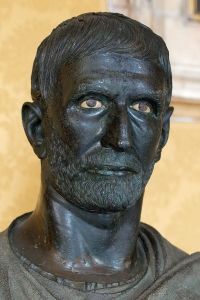
Many Roman sculptures were copies of Greek originals, but their ain contribution to Classical sculpture came in the form of portraiture. Emphasizing a realistic approach, the Romans felt that depicting notable men as they were, warts and all, was a sign of character. In dissimilarity, in Imperial Rome, portraiture turned to idealistic treatments, as emperors, beginning with Augustus, wanted to create a political epitome, showing them as heirs of both classical Greece and Roman history. Every bit a effect, a Greco-Roman style developed in sculptural relief as seen in the Augustan Ara Pacis (13 BCE).

The Romans besides revived a method of Greek glass painting to employ for portraiture. Most of the images were the size of medallions or roundels cut out of a drinking vessel. Wealthy Romans would have drinking cups made with a gilded glass portrait of themselves and, post-obit the owner'southward death, the portrait would be cutting out in a circular shape and cemented into the crypt walls as a tomb marking.
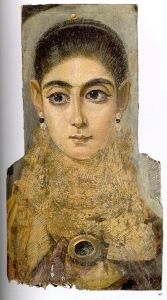
Some of the most famous painted Roman portraits are the Fayum mummy portraits, named for the place in Egypt where they were found, that covered the faces of the mummified dead. Preserved by Egypt'south arid climate, the portraits constitute the largest surviving grouping of portrait panel painting from the Classical era. Near of the mummy portraits were created between the 1st century BCE and the 3rd century CE and reverberate the intertwining of Roman and Egyptian traditions, during the time when Egypt was nether Rome's rule. Though arcadian, the paintings display remarkably individualistic and naturalistic characteristics.
Subsequently Developments - Later on Classical Greek and Roman Art and Architecture
The influence of Classical Fine art and architecture cannot exist overestimated, as information technology extends to all art movements and periods of Western art. While Roman architecture and Greek art influenced the Romanesque and Byzantine periods, the influence of Classical Art became dominant in the Italian Renaissance, founded upon a revival of interest in Classical principles, philosophy, and aesthetic ideals. The Parthenon and the Pantheon as well as the writings of Vitruvius informed the architectural theories and practice of Leon Battista Alberti and Palladio and designs into the modern era, including those of Le Corbusier.
Greek sculpture influenced Renaissance artists Michelangelo, Albrecht Dürer, Leonardo da Vinci, Raphael, and the subsequently Baroque artists, including Bernini. The discoveries at Pompeii informed the aesthetic theories of Johann Joachim Winckelmann in the 18th century and the evolution of Neoclassicism, as seen in Antonio Canova's sculptures. The modern sculptor Auguste Rodin was influenced primarily past the Parthenon Marbles, of which he wrote, they "had...a rejuvenating influence, and those sensations caused me to follow Nature all the more closely in my studies." Artists from the Futurist Umberto Boccioni, the Surrealist Salvador Dalí, and the multifaceted Pablo Picasso, to, later, Yves Klein, Sanford Biggers, and Banksy all cited Greek art every bit an influence.
Classical Art has also influenced other art forms, every bit both the choreography of Isidore Cunningham and Merce Cunningham were influenced by the Parthenon Marbles, and the start fashion garment featured in the Museum of Modern Art in 2003 was Henriette Negrin and Mariano Fortuny y Madrazos' Delphos Gown (1907) a silk dress inspired by the Charioteer Delphi (c. 500 BCE) which had been discovered a decade earlier. The legends, gods, philosophies and fine art of the Classical era became essential elements of subsequent Western civilization and consciousness.
Source: https://www.theartstory.org/movement/classical-greek-and-roman-art/history-and-concepts/
0 Response to "List 2 Characteristics From the Following Art Eras Classical Greece"
Post a Comment